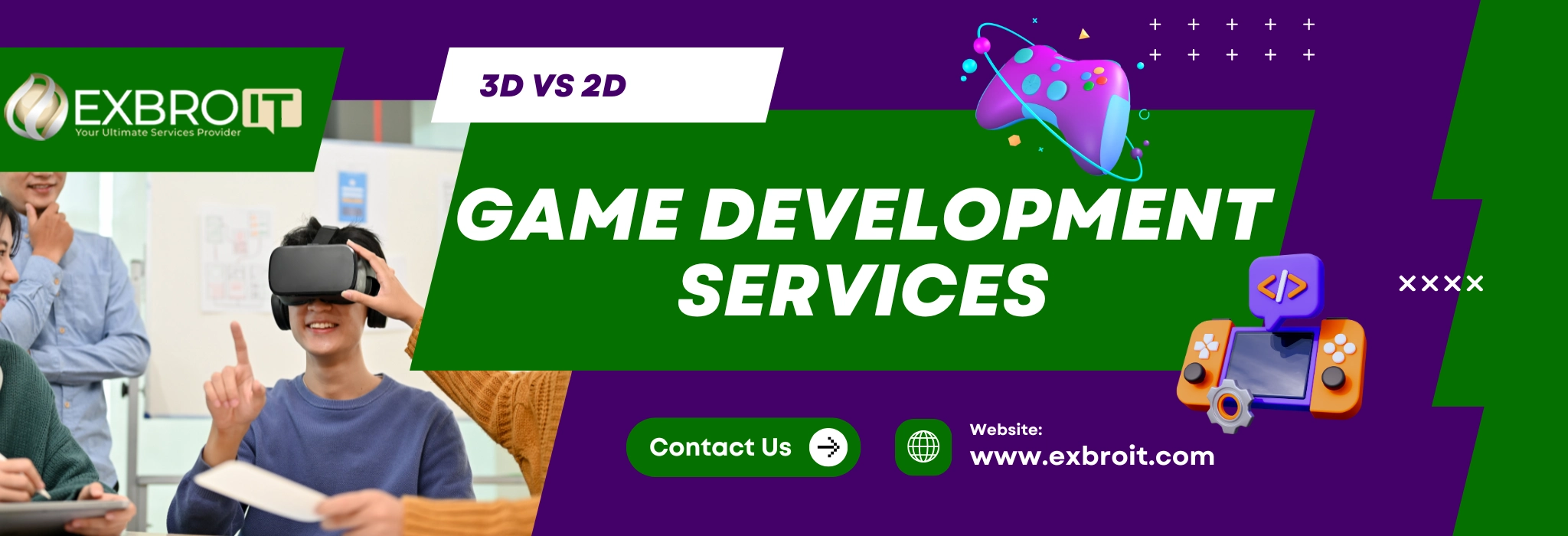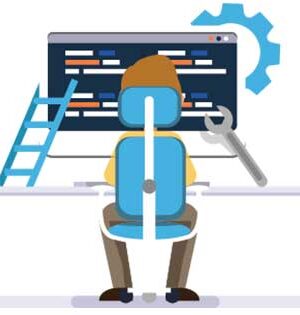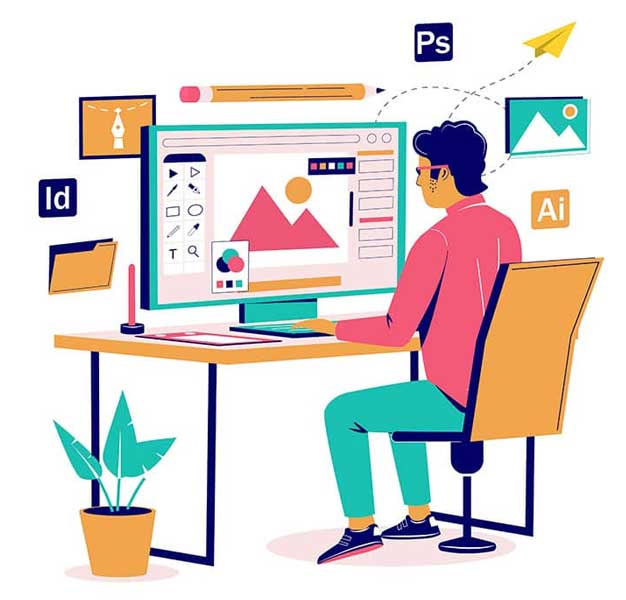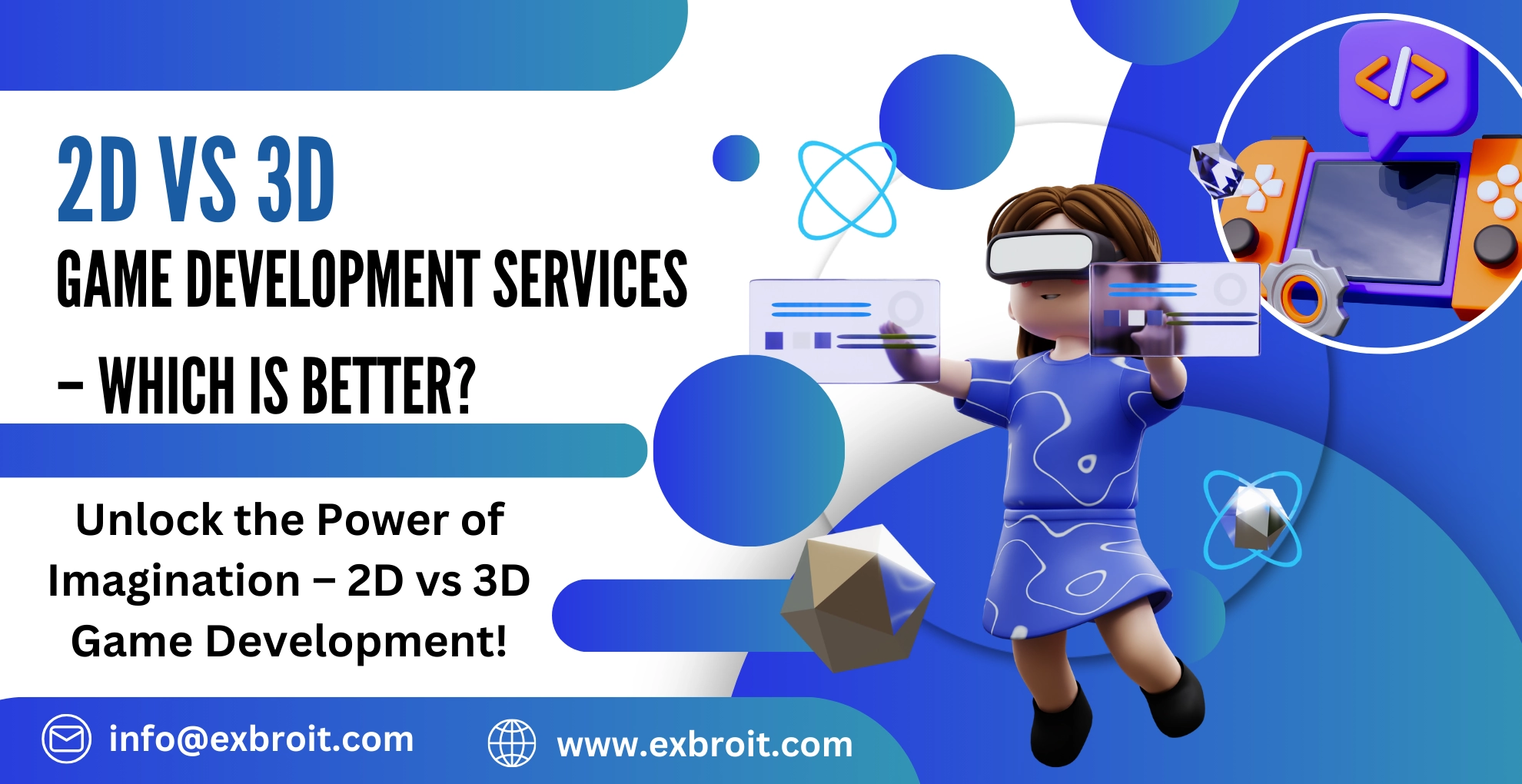The gaming industry has experienced an incredible transformation, with both 2D and 3D game development services playing a crucial role in shaping the future of interactive entertainment. Game developers, businesses, and startups often face a critical decision: should they opt for 2D game development services or invest in 3D game development services?
“2D games are timeless; their artistic design is often more iconic. However, 3D allows us to take players into new, fully realized worlds that just wouldn’t be possible otherwise.”
— Tetsuya Nomura
While both have unique advantages and challenges, choosing the right approach depends on your project requirements, target audience, and budget. In this in-depth comparison, we will explore the key differences, benefits, and use cases of both 2D and 3D game development services to help you make an informed decision.
Understanding 2D and 3D Game Development:
Before diving into a comparison, let’s define the two approaches:
What is 2D Game Development?
2D game development services involve creating games with flat, two-dimensional graphics. These games use sprites and backgrounds to create immersive yet simple visual experiences. Popular examples include classic arcade games, platformers, and mobile games.
What is 3D Game Development?
3D game development services focus on creating games with three-dimensional environments, realistic physics, and advanced visual effects. These games often provide immersive experiences with complex character movements and dynamic worlds.
Key Differences Between 2D and 3D Game Development Services:
| Feature | 2D Game Development | 3D Game Development |
|---|---|---|
| Graphics | Flat, two-dimensional visuals | Realistic, three-dimensional environments |
| Development Complexity | Easier and faster to develop | Requires more advanced skills and tools |
| Cost | Generally more affordable | Higher development costs due to complexity |
| Performance | Runs smoothly on low-end devices | Requires more processing power |
| Player Engagement | Simple yet engaging gameplay | Highly immersive experience |
| Use Cases | Mobile games, arcade games, casual games | AAA titles, VR/AR games, open-world adventures |
Advantages of 2D Game Development Services:
- Cost-Effective Game Development: Developing 2D games requires fewer resources, making it an ideal choice for indie developers and startups. Affordable game development services focus on 2D projects due to lower asset and animation costs.
- Faster Development Process: With fewer complexities, 2D game development services allow faster project completion. Developers can quickly prototype, test, and launch games, reducing time-to-market.
- Ideal for Mobile and Casual Gaming: Most mobile game development services rely on 2D due to its compatibility with smartphones and tablets. The lightweight nature ensures a smooth user experience on low-end devices.
- Classic and Retro Appeal: Games like Super Mario and Contra have proven the timeless appeal of 2D game development services. Many players still enjoy the nostalgic feel of pixel-art and cartoonish visuals.
Advantages of 3D Game Development Services:
- Enhanced Realism and Immersion: 3D game development services bring a higher level of realism, making gameplay more engaging. VR game development services rely heavily on 3D technology to create lifelike experiences.
- Greater Market Demand: With advancements in gaming consoles and high-end PCs, custom game development services focus more on 3D games. Players expect high-quality graphics and interactive environments.
- More Dynamic and Interactive Gameplay: Unlike 2D game development, 3D allows for smoother character movement, better camera angles, and intricate world-building. Games like Grand Theft Auto and Call of Duty highlight these advantages.
- Ideal for Virtual and Augmented Reality: As VR game development services gain popularity, 3D technology remains at the forefront. AR/VR applications require highly detailed environments, making 3D game development services the preferred choice.
Challenges of 2D and 3D Game Development:
While both 2D and 3D game development services offer significant benefits, they also come with challenges:
“The real challenge with 3D game development is not just creating realistic visuals, but also maintaining a strong sense of interaction and player engagement. 2D games are often more straightforward, yet equally capable of powerful storytelling.”
– Mark Cerny
I. Challenges in 2D Game Development:
- Limited visual appeal compared to 3D games.
- Lack of depth and realism, which may limit engagement.
- Less flexibility in world-building and character movement.
II. Challenges in 3D Game Development:
- Higher production costs, making it less budget-friendly.
- Longer development cycles, leading to delayed launches.
- More resource-intensive, requiring high-performance devices.
Choosing the Right Game Development Services for Your Project?
When deciding between 2D and 3D game development services, consider these factors:
1. Budget Constraints:
If you have a limited budget, affordable game development services focusing on 2D may be the best choice.
2. Target Audience and Platform:
For mobile and casual gamers, 2D game development services work well. However, if you’re targeting high-end consoles and PC gamers, 3D game development services offer more potential.
3. Game Genre:
Certain genres perform better in specific formats:
- 2D game development is ideal for platformers, puzzle games, and side-scrollers.
- 3D game development suits action, adventure, and simulation games.
4. Project Timeline:
If you need a game developed quickly, 2D game development services ensure a faster turnaround. 3D game development services, while time-intensive, offer richer gaming experiences.

Case Studies For 2D vs 3D Game Development Services:
I. Hollow Knight: 2D action-adventure game
Summary: Developed by Team Cherry, “Hollow Knight” is a critically acclaimed 2D action-adventure game known for its hand-drawn art and intricate level design. The game’s success underscores the potential of 2D games to deliver deep, engaging experiences with a distinctive artistic style.
II. The Legend of Zelda: Breath of the Wild
Summary: This open-world 3D game offers players the freedom to explore detailed environments, solve complex puzzles, and engage in combat within a vast, immersive world. Its success highlights the capabilities of 3D game development in creating expansive and interactive experiences.
III. Silent Hill: PlayStation’s limited
Summary: Faced with technological constraints, the developers of “Silent Hill” used the PlayStation’s limited draw distance to their advantage by incorporating an eerie fog into the game. This not only concealed hardware limitations but also enhanced the game’s atmospheric tension, showcasing how 3D game development can creatively overcome challenges to deliver a compelling experience.
Facts And Sources:
On the 3D front, “The Witcher 3: Wild Hunt” by CD Projekt Red exemplifies the capabilities of 3D game development services. The game features a vast, open-world environment with realistic graphics and complex character models, providing an immersive experience that has been lauded by both players and critics. This case illustrates how 3D development can enhance storytelling and player engagement through detailed visual and interactive elements.
General FAQs:
1. Which is more cost-effective: 2D or 3D game development services?
2D game development services are generally more cost-effective than 3D due to simpler graphics, lower production costs, and faster development time. 3D games require more resources, advanced modeling, and rendering, which increases the overall budget. If you’re a startup or indie developer, 2D game development may be the better option.
2. Which is better for mobile games: 2D or 3D game development?
2D game development is often the preferred choice for mobile games because it is lightweight, requires less processing power, and runs smoothly on a variety of devices. However, with advancements in mobile hardware, 3D game development is becoming more common for high-end mobile gaming experiences.
3. What are the advantages of 3D game development over 2D?
3D game development offers a more immersive experience, realistic graphics, and dynamic gameplay. It is ideal for action-packed genres, open-world games, and VR experiences. However, it requires more time and expertise to develop compared to 2D games.
4. Can I convert a 2D game into a 3D game later?
Yes, but it requires significant redevelopment. While some assets and mechanics may be adapted, transitioning from 2D to 3D often involves redesigning levels, animations, physics, and gameplay elements. It’s best to decide early in development whether 2D or 3D game development services align with your long-term vision.
5. How do I choose between 2D and 3D game development services for my project?
Consider your budget, target audience, and game genre. If you want a cost-effective, simple, and nostalgic game, 2D is a great option. If you aim for high-end visuals, immersive storytelling, and a realistic gaming experience, 3D game development is the way to go. Consulting with a professional game development company can help you make the best choice.
Final Verdict – Which is Better?
There is no clear winner between 2D and 3D game development services—it all depends on your project goals. If you prioritize affordability, fast production, and mobile compatibility, go for 2D game development services. However, if you aim for immersive graphics, realism, and next-gen gaming, 3D game development services are the way to go.
“The most important thing is to create a game that’s fun, regardless of whether it’s 2D or 3D. The medium is just a tool to engage players.”
– Hideo Kojima
Looking for expert game development services? Whether you need a stunning 2D game development solution or an advanced 3D gaming experience, ExbroIT has you covered. Our team specializes in custom game development services, VR game development services, and more.










